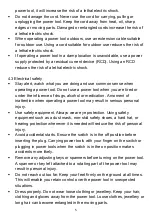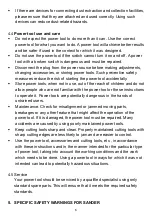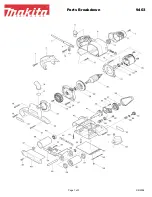
7
When working with the machine, always hold it firmly with both hands
and provide for a secure stance. The power tool is guided more
securely with both hands.
Do not work with materials containing asbestos. Asbestos is
considered carcinogenic.
Take protective measures when dust can develop during working that
is harmful to one
’
s health, combustible or explosive. Wear a dust
mask and work with dust/chip extraction devices.
Keep your workplace clean. Blending of certain materials can be
particularly dangerous.
Never use the machine with a damaged cable. Do not touch the
damaged cable and pull the mains plug when the cable is damaged.
Damaged cables increase the risk of an electric shock.
Use the machine only for dry sanding. Penetration of water into the
machine increases the risk of an electric shock.
Use suitable detectors to determine if utility lines are hidden in the
work area or call the local utility company for assistance. Contact with
electric lines can lead to fire and electric shock. Damaging a gas line
can lead to explosion.Penetrating a water line causes property
damage or may cause an electric shock.
6. ASSEMBLY AND OPERATION
Use before
Use the sander revision for dust collection (Fig.2)
Note the use of dust extraction works only with perforated sanding paper.
Abraded material is only partially absorbed. A part of the dust remains on
the work piece.
Dust removal (Fig.2a-2c)
The tool is provided with its own dust removal system.
Connect the dust collection box to the corner sander as shown.
Fitting sanding sheets (Fig.3)
Take sanding paper of the required grain size and place it on the sanding
base plate (Fig.3). Make sure that the perforations in the paper
correspond with those on the sanding pad.






























